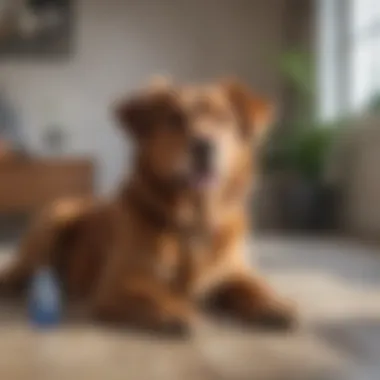The Best Pet Safe Air Fresheners: An In-Depth Analysis


Intro
Choosing an air freshener has become an everyday task for many households aiming to maintain a pleasant atmosphere. However, for pet owners, this seemingly simple choice can sometimes feel like navigating a minefield. Many traditional fresheners contain chemicals that can be harmful, even fatal, to beloved pets. This reality necessitates a deeper examination of safe alternatives designed specifically with our furry companions in mind.
When it comes to pet-safe air fresheners, it's imperative to recognize that not all products labeling themselves as "natural" or "organic" truly meet the safety standard for animals. Various factors contribute to the creation of a pet-friendly environment and understanding these elements will equip owners to make informed decisions when choosing how to scent their homes.
As we delve into this analysis, we will discuss the critical insights regarding ingredients to look for, as well as those to avoid; the type of air fresheners available, such as sprays, plug-ins, and diffusers; and provide some recommendations for products that have garnered positive feedback from fellow pet owners. This exploration aims to educate and arm you with knowledge, ensuring your home remains not only freshened up but also a safe haven for your pets.
Importance of Pet-Friendly Options
Air fresheners are often used to mask unpleasant odors within the home. Yet, what many might not realize is that the scents we love may pose a threat to our pets. For instance, certain essential oils, while aromatic, can be toxic to cats and dogs if ingested or inhaled in significant quantities. This is where pet-safe alternatives shine, allowing owners to create a warm and inviting atmosphere without the fear of jeopardizing their pets’ health.
Key Considerations
In discussing air fresheners that are safe for animals, we need to consider multiple elements:
- Ingredients: Not all ingredients are safe; it's crucial to research potentially hazardous elements like phthalates and certain synthetic fragrances.
- Chemical Safety: Familiarizing oneself with labels and certifications can help pinpoint truly pet-safe products.
- Natural Solutions: Some may prefer diy methods to create a pleasant scent in their homes, utilizing baking soda, vinegar, or safe herbs, thereby sidestepping commercial products entirely.
As we continue, we'll dive deeper into these topics and provide specific product recommendations tailored for pet owners. Remember, ensuring your home is a safe place for all its inhabitants—human or animal—is of the utmost importance.
Understanding the Importance of Pet Safety
The safety of our beloved animals is paramount when it comes to creating a comfortable living environment. As pet owners, we often seek to make our homes more inviting, but sometimes we might overlook the potential hazards that conventional air fresheners can pose. It's essential to understand the balance between freshness and the well-being of our furry friends. Many products on the market today contain a cocktail of chemicals that can be harmful to pets, often without our realization.
Choosing pet-safe air fresheners ensures that we can enjoy a pleasant aroma in our homes without compromising the health of our companions. It’s about protecting them from harmful substances while maintaining an inviting atmosphere for ourselves and guests alike. As we delve deeper into the signs of air freshener toxicity and the specific dangers linked to typical air freshening products, understanding this importance becomes clearer.
Risks Associated with Conventional Air Fresheners
Conventional air fresheners can sometimes have fragrances that mask odors rather than eliminate them, which might seem beneficial at first. However, the chemicals used to create those pleasant scents can be rather troublesome for pets. Ingredients like benzene and toluene, often found in aerosol sprays, have been linked to various health issues. These substances can irritate your pet’s eyes and respiratory systems.
Moreover, many air fresheners contain phthalates, which are known to disrupt hormones and can affect your pet's behavior and reproductive health. Cats and dogs have a heightened sense of smell compared to humans, meaning that these chemicals can impact them much more severely. For some pets, simply inhaling these harmful compounds can lead to lethargy or agitation. It’s important for pet owners to recognize that what may smell delightful to us as humans can actually be irritating or even toxic for our pets.
Common Symptoms of Air Freshener Toxicity
Knowing the signs that your pet may be adversely affected by air fresheners is crucial. Symptoms can range from mild to severe, requiring immediate attention. Some of the common indicators of air freshener toxicity include:
- Coughing or sneezing: This could signal respiratory irritation.
- Excessive drooling: Often a sign of nausea or distress.
- Lethargy: A notable change in energy levels can indicate a problem.
- Vomiting or diarrhea: This can occur if a pet ingests any of these harmful substances.
- Behavioral changes: Unusual aggression or withdrawal can be indicative of distress.
If you observe any of these symptoms after using an air freshener, it is advisable to switch to pet-safe alternatives swiftly.
"Safety should always come first, not just for ourselves but for our four-legged companions who rely on us to keep them sheltered from harm."
By being proactive and understanding the risks associated with conventional air fresheners, pet owners can take significant steps toward fostering a healthier environment for their pets.
Key Ingredients to Avoid


When it comes to creating a comfortable and pleasant living space, pet owners often reach for air fresheners without fully understanding what goes into them. The goal should be to have a home that smells nice while ensuring the well-being of beloved furry companions. It's vital to recognize potential dangers lurking in the ingredients. This section seeks to shed light on key substances that can pose significant risks to pets, allowing for more informed decisions when choosing air fresheners.
Phthalates and Their Impact
Phthalates are a group of chemicals utilized in various household products, including air fresheners, to enhance texture and enhance scent longevity. They are often hidden as part of "fragrance" ingredients on labels. Unfortunately, phthalates have been linked to a whole host of health issues. Notably, they can disrupt hormonal balance in both animals and humans.
Pets are particularly vulnerable to these chemicals. They may experience symptoms like excessive scratching, vomiting, or even more serious hormonal disruptions over time. Furthermore, studies suggest that prolonged exposure to phthalates can lead to developmental issues in pets. Knowing that phthalates aren’t always explicitly listed on product packaging under that name can be discouraging, which makes it even more imperative to prioritize natural options.
Formaldehyde: A Hidden Danger
Formaldehyde is another ingredient worth avoiding. Although many may associate it mainly with industrial uses or preservation, it often sneaks into household products, including some air fresheners. The danger? This substance is known to cause irritation to the respiratory system, which is concerning because pets often breathe close to the ground where these chemicals settle.
Pets living in enclosed spaces where formaldehyde is present can develop coughing, sneezing, or even trigger more severe conditions like asthma or chronic bronchitis. It's crucial for pet parents to steer clear of products that may contain this dangerous compound. While freshness is desired, the potential effects are hardly worth the risk.
Synthetic Fragrances and Allergens
Synthetic fragrances are prevalent in many air fresheners. Here lies a dilemma, the delightful scent these products promise can come at a steep price. Often, these "fragrance" additives, composed of various chemicals, can lead to allergic reactions in pets just as much as in humans. Symptoms might range from mild irritations to severe respiratory difficulties, really depending on the sensitivity of the animal.
Additionally, synthetic fragrances can accumulate in the home environment, leading to an overwhelming chemical exposure for pets. This constant barrage can make pets uneasy and, in some cases, lead to behavioral changes. Instead of reaching for a commercial air freshener, consider opting for natural alternatives, as they minimize risks while still maintaining freshness.
It’s crucial for pet owners to always read labels and be proactive in ensuring that their air fresheners do not contain harmful ingredients, therefore fostering a safer home environment for their furry companions.
Types of Pet Safe Air Fresheners
In an environment where our pets are cherished members of the family, ensuring that the air they breathe is safe becomes paramount. The topic of pet safe air fresheners is not merely a preference; it’s a necessity for any responsible pet owner. Conventional air fresheners can be loaded with ingredients that may cause harm to our furry companions. Hence, exploring pet-friendly alternatives becomes essential.
By focusing on types of pet safe air fresheners, we can delve into specific benefits and considerations associated with various options. These alternatives can help maintain a pleasant ambiance in our homes without risking the health of our pets.
Natural Essential Oil Diffusers
Natural essential oil diffusers have gained popularity as an effective way to maintain pleasant scents while steering clear from harmful chemicals. Essential oils like lavender, chamomile, and peppermint are not just pleasing to the nose, they can also have calming effects on both humans and animals. However, caution is key here.
Not all essential oils are safe for pets. For instance, tea tree oil can be toxic to cats and dogs. It's always wise to ensure that any oil used is safe for your specific type of pet. Additionally, using a diffuser that releases essential oils in low concentrations can help minimize potential risks.
Here are some tips for using natural essential oil diffusers safely:
- Choose pet-safe oils: Stick with oils that are not known to be toxic for pets.
- Control diffusion: Ensure the diffuser does not run continuously to lessen exposure.
- Ventilate your space: Open windows or use fans to prevent too strong of an aroma that might be overwhelming for your pets.
"Essential oils have the power to make your home smell delightful, but knowing which ones to use around pets is crucial."
Baking Soda-Based Fresheners
Baking soda is not just for baking; it’s also a versatile odor neutralizer. This humble household item has been proven to absorb unpleasant smells without introducing any harmful chemicals into the air. When it comes to freshening up spaces shared with pets, this is a reliable option.
Sprinkling baking soda on carpets or placing open containers around the house can keep odors at bay. You can even create a simple baking soda spray by mixing baking soda with water, and using it on surfaces that need freshening. Here’s how to effectively use baking soda as an air freshener:


- Sprinkle and vacuum: Dust baking soda over carpets, let it sit for 15 minutes, and vacuum to eliminate smells.
- Make a spray: Mix three tablespoons of baking soda with a quart of water in a spray bottle for a simple air freshener.
- Combine with essential oils: If desired, add a few drops of pet-safe essential oil to the baking soda spray for fragrance.
Activated Charcoal Solutions
Activated charcoal is another natural option that has garnered attention for its unique ability to trap odors and impurities. It works by absorbing chemicals and smells from the air, making it an effective freshener in spaces where pets dwell. It’s a simple, non-toxic solution that can provide a significant benefit to pet owners.
Using activated charcoal comes with advantages:
- Odor absorption: Unlike masking the smell, it actually removes it from the environment.
- Non-toxic: Activated charcoal is safe for pets, provided they do not consume it in large quantities.
- Versatile: You can find it in various forms, such as sachets or loose powder, which you can place in pet areas or rooms needing freshness.
To maximize the effectiveness of activated charcoal:
- Placement: Position charcoal bags in high-traffic pet areas or places with persistent odors.
- Regular replacement: Change out the charcoal every few weeks to maintain its odor-absorbing efficiency.
With a range of options available, pet owners can choose the right type of air freshener suited for their home. Each type offers distinct benefits and requires some degree of caution; educating oneself about these solutions ensures a safer and more pleasant living space for both pets and their owners.
Homemade Air Freshening Solutions
In the quest to create a pleasant atmosphere in our home, many pet owners are turning to homemade air freshening solutions. These options offer a natural alternative to conventional products that often contain potentially harmful ingredients. Homemade solutions not only reduce the risks associated with chemical-based fresheners but also provide flexibility and personalization based on one’s preferences.
Making air fresheners at home can be simple and cost-effective. Furthermore, they often leverage ingredients that are safer for pets, providing peace of mind without compromising on freshness. As a bonus, these DIY options allow pet owners to control the ingredients, ensuring that what they use is both safe and effective.
Crafting Natural Oil Sprays
Creating natural oil sprays is a straightforward yet rewarding task. By blending essential oils with water or vinegar, pet owners can concoct their own air fresheners tailored to their liking. Lavender, lemon, and peppermint are popular choices, known for their pleasing aromas. To make your spray:
- Choose a clean spray bottle.
- Fill it with 2 cups of water.
- Add 10-15 drops of your chosen essential oil.
- Optionally, include a tablespoon of vodka (helps blend the oils) or vinegar.
- Shake well before each use.
It's vital to remember that not all essential oils are pet-friendly. Avoid using oils like tea tree or eucalyptus, as these can be detrimental to pets. As with any new product, start with a small spritz to see how your pet reacts.
Using Vinegar for Odor Control
Vinegar is one of those unsung heroes in the realm of home cleaning and freshening. Its acidic nature helps neutralize odors effectively, making it a reliable choice for pet owners. To effectively use vinegar:
- Mix equal parts water and vinegar in a spray bottle.
- Spray it on surfaces as needed, allowing it to settle for a few minutes before wiping it away. This method not only masks unpleasant smells but eliminates them at the source.
"Vinegar can transform your home into a more inviting space, proving that sometimes the simplest solutions are the best."
For spaces that collect pet odors, such as carpets or couches, consider spraying the solution lightly and letting it air dry. The vinegar smell dissipates, leaving behind a fresher atmosphere.
Herbal Sachets for Freshness
Herbal sachets are another delightful way to infuse your living space with pleasant scents while maintaining safety for your furry friends. These sachets can be as simple or complex as you prefer, using dried herbs that both scent and freshen while also offering anti-bacterial properties. Common contenders for inclusion are:
- Lavender: known for its calming properties.
- Rosemary: a fantastic deodorizer.
- Mint: refreshing and invigorating.


To create your herbal sachet:
- Gather dried herbs and a small pouch (muslin, cheesecloth, or even a clean sock can work in a pinch).
- Fill the pouch with the herbs and tie it securely.
- Place sachets in drawers, closets, or even under cushions.
These sachets can last for weeks, and when the scent fades, you can refresh them by lightly crushing the herbs within or replacing them altogether.
Review of Top Pet Safe Air Fresheners
When it comes to the flourishing world of air fresheners, the importance of selecting products that won’t compromise the well-being of our pets cannot be overstated. The review of top pet safe air fresheners serves as a crucial guide for conscientious pet owners who wish to maintain a fresh-smelling home without putting their furry companions at risk. In this section, we delve into the various offerings available, highlighting their effectiveness and safety profiles.
Product Comparisons and Ratings
The market offers a wide variety of air fresheners labeled "pet safe," but not all of them measure up. A careful comparison of products based on ingredients, scent longevity, and user feedback is vital to make an informed choice.
- Natures Miracle Triple Action Odor Destroyer
This product uses plant-based ingredients and is quite popular among pet owners. Its effectiveness in breaking down odors deals well with pet messes. An average rating of 4.7 stars reflects its robust reputation in the community. - PetSafe Lavender Oasis
Specially formulated with essential oils, this air freshener serves as both a fragrant enhancer and a calming agent for pets. Many reviews commend its pleasant scent without overpowering the delicate senses of animals. - Poochee Pet Odor Eliminator
Focusing on eliminating the sources of odors rather than just masking them, it comes with a unique enzymatic formula. Users have rated it highly for its efficacy, scoring an average of 4.5 stars.
Product differences expose various strengths: some emphasize odor elimination, while others focus on creating a welcoming ambiance. It's important to consider not just the advertised benefits but also the ingredients list detailed on the packaging.
User Experiences and Feedback
What better way to gauge a product's reliability than by tapping into the collective wisdom from pet owners who have gone before you? User experiences provide invaluable insights beyond sterile product claims. Here’s a snapshot of what they’re saying:
- Allergy Concerns: Several users reported their pets had shown allergic reactions to certain scents. Many recommend testing a small area first or starting with light applications.
- Longevity and Efficacy: Owners of multiple pets commonly discussed the challenge of finding an air freshener that lasts. Products like Natures Miracle seem to get high marks for longer-lasting freshness even in households with several furry friends.
- Calming Effects: A notable trend in the feedback revolves around air fresheners with lavender or chamomile. Users observe that these scents appear to have a calming effect that benefits both pets and humans alike.
"Finding something that keeps our home fresh without worrying about our pets makes all the difference. Our dog isn't sneezing anymore, and the house smells divine!"
User feedback also highlights a dual responsibility: maintaining a pleasant atmosphere while prioritizing the health of our pets. This synthesis of experiences ultimately shapes the reputation of various products, guiding new consumers towards safer choices.
By considering product ratings and user feedback, it becomes clearer which air fresheners uphold their promise of being pet-safe and effective. Knowledge is power, especially when it comes to our beloved companions.
Epilogue: Making Informed Choices
Navigating the world of air fresheners with pets around is no small feat. It’s a constant balancing act between creating a welcoming environment in your home while ensuring that your furry companions remain safe from harm. This article sheds light on why choosing pet-safe options is not just a preference; it’s a necessity. The discussion surrounding this topic extends beyond mere fragrance – it dives into the intricate relationship between household products and pet health.
Balancing Freshness with Safety
When it comes to keeping your home smelling fresh, the options can feel overwhelming. Many commercially available air fresheners pack a punch in the smell department, but they can also unleash a host of chemicals that might cause more harm than good. The key is to strike a balance. You might find yourself asking, "How can I achieve that without endangering my pets?"
To help in this balancing act, consider the following points:
- Opt for natural alternatives: Essential oils like lavender or lemon can provide pleasant scents without the chemicals.
- Neutralize odors instead of masking them: Products containing baking soda or vinegar work wonders to eliminate odors at their source.
- Read labels like a hawk: Scrutinize ingredient lists and avoid any unrecognizable additives. Remember, if you can’t pronounce it, it might not belong in your home.
"Creating a welcoming space should not come at the expense of our pet’s well-being. Let’s prioritize their health while maintaining our home’s comfort."
The challenge lies in making sure these choices don’t irritate your pets. Animals have much more sensitive noses than humans. What smells heavenly to us might be unbearable for them.
Ongoing Monitoring of Pet Health
Even after you've made informed choices, it's essential to remain vigilant. Regular monitoring of your pets' health can help catch any adverse reactions early on. Look for signs of discomfort, such as:
- Increased scratching or grooming
- Unexpected lethargy
- Changes in behavior or appetite
- Respiratory issues, like coughing or wheezing
If you notice any of these symptoms, it’s worth considering possible links to the environment around them, including air fresheners. Your awareness can safeguard your pets and ensure a pleasant home atmosphere.







